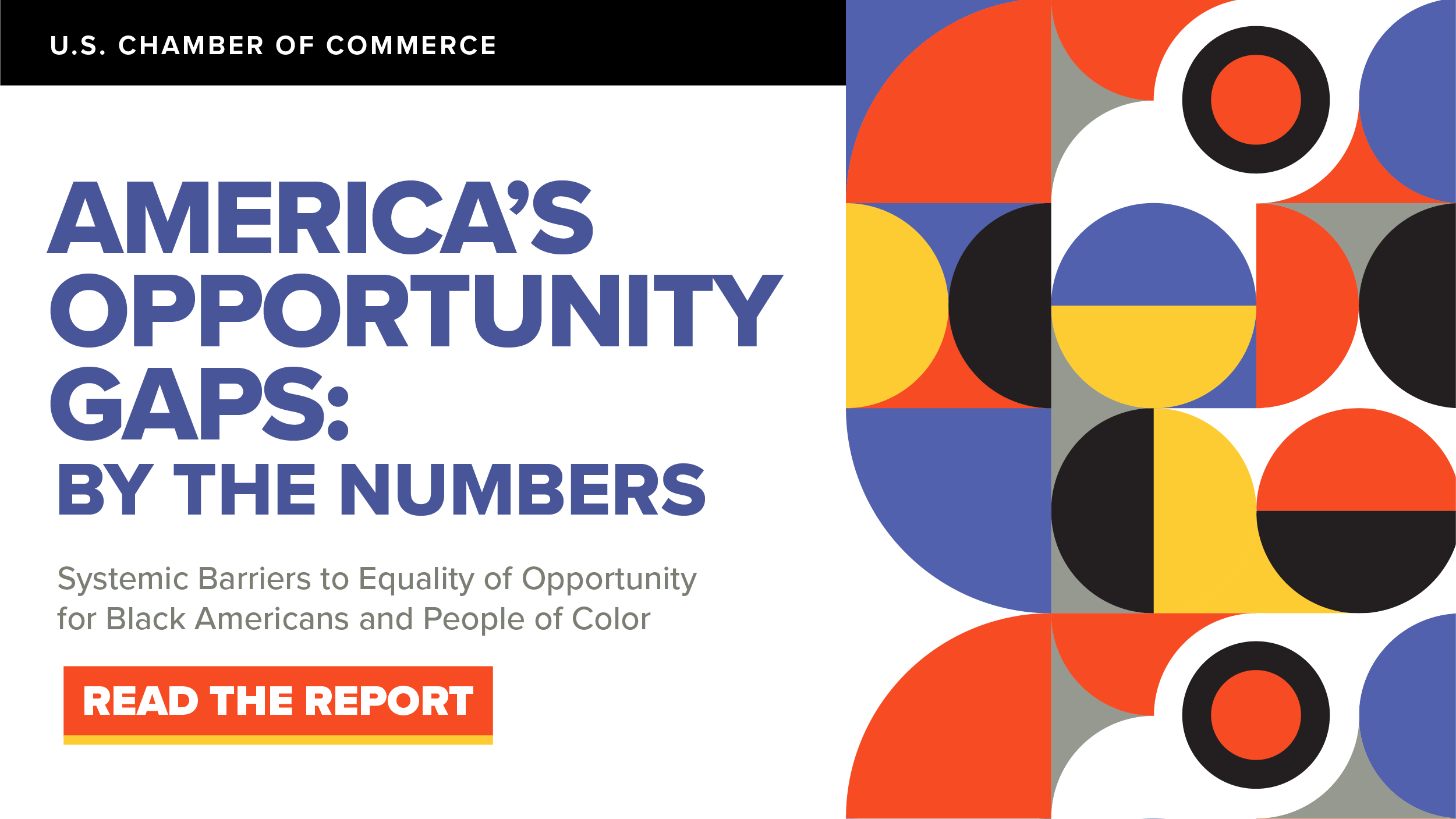|
Our Tribe!
|

The U.S. Chamber of Commerce launched the Equality of Opportunity Initiative to address opportunity gaps that perpetuate broader inequalities in our society and hold back individual and business success and economic growth. In order to drive meaningful, measurable impact through public policy and private sector solutions, we must listen, learn, and lead.
We compiled this research to show the magnitude of opportunity gaps in six key areas. The findings below will inform our work as we pursue targeted, data-driven, and sustainable solutions that will help deliver the American promise of equal opportunity to all.
Download the Full Report Watch THE SUMMIT
JUMP TO:
Education | Employment | Entrepreneurship | Criminal Justice | Health | Wealth
Sign up to receive the latest news, resources and event updates related to the
Equality of Opportunity Initiative.
EDUCATION
21%
Average math scores for Black students entering kindergarten are 21% lower than those of white students
Racial disparities in learning begin even before formal schooling starts. The “achievement gap” for children begins shortly after birth, with early learning experiences varying considerably based on parents’ income level. In everything from the number of words a young child hears to access to resources like museums or libraries, there is a strong correlation between socioeconomic status and early learning.
The rate of Black American children living in poverty is more than double that of white children, which means these disparities are distributed unequally across racial lines. Black students are twice as likely to attend high-poverty schools as their white peers, and 60% attend high-poverty non-white schools. The average per pupil spending in high-poverty, non-white school districts is $1,500 less than the national average.
2x
Black students are twice as likely to attend high-poverty schools as white students
Only one in five Black 4th graders are reading on grade level compared to half of the white students. Just 14% of Black 8th graders are on grade level in mathematics, 20% below the rate for all students combined.
As students get older, roughly 45% of Black students receive no formal education beyond high school and only 15.3% receive a bachelor’s degree, compared to more than 23% of white students.
EMPLOYMENT
2x
Black unemployment rates have been consistently twice as high as white unemployment rates for the past four decades
Racial disparities extend beyond education to employment and access to different occupations.
For the past four decades, Black unemployment rates have been consistently twice as high as white unemployment rates. Across six major categories of occupations ranked by 2019 median weekly earnings, 23% of Black (non-Hispanic) workers were employed in the lowest earning groups (manual labor and service occupations) and 25.7% in the highest earning groups (management, professional, and technical occupations). For non-Hispanic white workers, the percentages are 13.3% and 50.4% respectively.
8.9%
Black American representation in “high earning management and professional” roles, less than their 12% workforce representation
At the same time, disparities in earnings along racial and gender lines are evident across similar occupations and education levels. For example, within “high earning managerial and professional” roles in 2019, the median weekly earnings for non-Hispanic white men was $1,538, while for non-Hispanic Black men the median was $1,167. A smaller gap exists for women.
The pandemic has exacerbated these trends. Black unemployment rose to 16.8% in May, up from 6.0% in January 2020, as compared to white unemployment which was 12.4% in May and 3.1% in January. During the pandemic, Black (23%) and Latinix (24%) workers are more likely than white (15%) and Asian Americans (13%) to have been laid off.
ENTREPRENEURSHIP
3x
Black entrepreneurs are nearly three times more likely than white entrepreneurs to have business growth and profitability negatively impacted by a lack of financial capital
Entrepreneurship plays an important role in building wealth in families, communities, and economies, but the opportunity to start and grow a business is not equal for white and Black Americans. Black Americans are underrepresented among entrepreneurs, representing 12% of the U.S. labor force but only 9.4% of business owners. They also are less likely than white Americans to launch businesses, and when they do, those businesses tend to have lower revenues and fewer employees.
Research has shown that these disparities can be explained in large measure by persistent gaps in access to financial capital and what’s commonly referred to as human capital (education and experience).
Black-owned non-employer businesses are less than half as likely to get financing as white-owned firms; as a result, Black entrepreneurs are nearly three times more likely to have business growth and profitability negatively impacted by a lack of financial capital. Given that 70.6% of Black entrepreneurs rely on personal and family savings for financing, lower family wealth for Black families overall (see: Wealth section below) drives more of a divide in access to capital. In addition, Black Americans hold higher levels of student debt, which has been shown to inhibit entrepreneurship by discouraging risk and inhibiting access to capital.
The economic fallout from the pandemic has hit Black-owned and Hispanic-owned firms particularly hard, exacerbating these challenges. The number of Black-Americans who are self-employed dropped by a staggering 41% from February to April while the number of Latinx non-employer entrepreneurs dropped 32%, compared to a 17% drop for white entrepreneurs. This was due in part to industry concentrations that put Black- and Hispanic-owned businesses at higher risk of disruption and loss caused by the pandemic.
9 Million
The number of jobs that would be created if the number of minority-owned businesses increased to be proportional to minority labor force participation
Closing racial divides in entrepreneurship would provide a significant infusion of jobs and economic growth. A recent study found that if the number of people-of-color-owned firms was proportional to their labor force participation, the U.S. would add more than 1.1 million businesses, supporting an estimated nine million additional jobs and adding nearly $300 billion in workers’ income. A separate study estimated that more equitable access for the Black community to tools businesses need would generate an additional $8 trillion in U.S. GDP growth.
CRIMINAL JUSTICE
40%
Black Americans represent 40% of the incarcerated population in the U.S. but only 13% of the total U.S. population
Black Americans represented 27% of all individuals arrested in America in 2016, about twice their proportion of the total population. In Washington, D.C., 2019 data showed that despite making up 46.5% of the city’s population, Black Americans composed 72% of the people stopped by police. Even when no arrests are made, Black Americans are 21% more likely to experience some form of physical force during interactions with the police.
Black Americans are more likely than white Americans to be arrested. Once they are arrested, they are more likely to be convicted. And once convicted, they are more likely to experience lengthy prison sentences. Black Americans comprise 13% of the U.S. population, but 40% of the incarcerated population, and Black Americans are incarcerated in state prisons at 5.1 times the rate of white Americans.
65%
A criminal record reduces employer callback rates by 65% for Black American men, compared to a 50% reduction for white men
It is also harder for Black Americans to bounce back economically after incarceration. A criminal conviction limits employment prospects as well as access to housing and public assistance. Re-entry into the labor market is especially challenging. A criminal record, gaps in education and employment, and the stigma of incarceration limit opportunities. Having a prior conviction reduces employer callback rates by 65% for Black male job applicants, compared to a 50% reduction for white male applicants.
HEALTH
2x-3x
Black patients are 2 to 3 times as likely to die from preventable heart disease and stroke than white patients
Black Americans have markedly worse health outcomes than white Americans. Black patients are 2 to 3 times as likely to die of preventable heart disease and stroke than white patients. They also have higher rates of cancer, asthma, influenza, pneumonia, diabetes, HIV/AIDS, and homicide.
This trend has been pronounced during the pandemic. While Black Americans represent 13% of the population, based on available COVID-19 case data, they account for 22% of coronavirus cases, with a significantly higher rate of hospitalization and death. When adjusted for age, the COVID-19 death rate for Black Americans is 3.6 times that for white Americans.
Social determinants of health—the conditions in which people are born, grow, live, play, learn, work, and age—have a tremendous impact on the health of individuals. Using emergency room visits as a proxy, analysis has concluded that social determinants of health were associated with low primary care access and high emergency room department utilization.
Access to primary care helps people live longer, healthier lives. In areas of the country where there are more primary care providers per person, death rates for cancer, heart disease, and stroke are lower, and people are less likely to require hospitalization. Additionally, U.S. adults who have primary care physicians accumulate 33% lower healthcare-related costs. Race is associated with these access-to-care access disparities, with Black Americans adversely and disproportionately impacted by poor access to health care.
3.6x
The COVID-19 death rate for Black Americans is 3.6 times the rate for white Americans when adjusted for age
A racial gap in health insurance also exists. In 2018, 54.4% of Black Americans had private healthcare insurance provided by an employer or union, purchased directly or TRICARE – compared to 74.8% for non-Hispanic whites, 73.1% of Asians, and 49.6% of Hispanics.
WEALTH
10x
The net worth of a typical white family is almost 10 times the net worth of the average Black family
There are significant racial disparities in wealth in America. At $171,000, the net worth of a typical white family is nearly ten times greater than that of the average Black American family ($17,150). In addition, Black Americans are much more likely to experience poverty: 21% of Black Americans and 8% of whites live below the poverty level, though there have been improvements in recent years.
Wealth disparities are reflected in everything from retirement planning to homeownership to net worth. While 60% of white families contribute to retirement accounts, only about 33% of Black American families hold assets there. A recent report showed that Black Americans had balances of $30,000 in their retirement accounts, while white women and men had balances of $60,000 and $101,000, respectively. As a result, Black Americans are at substantially greater risk of being poor in retirement.
33%
The percent of Black families contribute to retirement accounts, about half the rate for white families (60%)
The disparities extend to homeownership. According to a 2016 Federal Reserve report, growth in homeownership increased from 70.5% to 75.6% for white Americans between 1989 and 2007. Over the same period, Black American homeownership rose from 42.4% to 49.3%.
In order to drive meaningful, measurable impact through public policy and private sector solutions, we must first listen and learn. This research informs our work as we pursue targeted, data-driven, and sustainable solutions that will help deliver the American promise of equal opportunity to all.”
– Suzanne Clark, President, U.S. Chamber of Commerce
